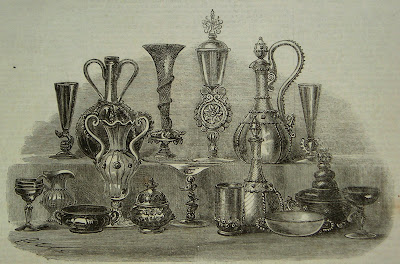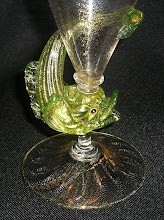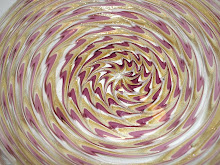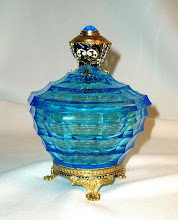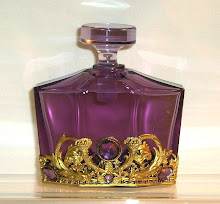
["CHALICES AND TAZZE. (After Old Examples of Murano Glass.)"]
[Click photo to enlarge]
It is a mistake ever to have spoken of glass-making in Venice as a lost art. The city has always preserved her ancient traditions. The smouldering fires in the workshops of Murano had been kept alight by the continued manufacture of beads and mosaic; it wanted but a gentle breath of appreciation to fan them again into a steady flame. A few exquisite specimens of minute mosaic made in 1838, now preserved in the South Kensington Museum, bear witness to the skill of Radi; and though the workmen had lost much of their old skill, yet glass-blowing (soffiati) was practiced in Murano, as many visitors can attest. In 1842 an effort at revival was made, when Bussolin and Bigaglia produced on a small scale filigree and other kinds of glass -- objects principally made with great care from the directions of antiquarians, who possibly may have wished to sell them as antiques. The first great revival of artistic and industrial glass-making was due to the late Abbe' Zanetti, who founded the museum for ancient glass at Murano, of which for many years he was director. He also founded the School of Design in the island -- a school which has no State aid, but is supported by the municipality. Zanetti devoted great learning and much patient research to the re-discovery of the chemical processes of colouring glass, and analyzed many specimens dredged up from the canals. He was thus enabled materially to assist the modern workers who applied to him for instruction. About 1858 the municipality of venice determined to restore some of the mosaic in St. mark's, and Radi applied for the concession. It was at this time that the late Dr. Salviati -- then a lawyer in Vincenza -- became associated with Radi in glass-making. He succeeded, notwithstanding the strict Austrian Custom House, in sending specimens of Venice glass to the Florentine Exhibition in 1861, and to him belongs the credit of having introduced the manufacture to the English public who for some time rewarded him by calling all Venetian glass by his name. Assisted by the late Baron Heath, vice-Consul for Italy, he started a shop in London for the sale of blown-glass, which, however, was not a financial success, and would soon have failed had not some English gentlemen -- Sir Henry Layard and Sir William Drake in particular -- decided to found a glass company, to the management of which they appointed Salviati in 1866. This powerful company built the well-known ateliers on the Grand Canal, Venice, close to the Salute Church, and collected for the first time under one roof a large staff of mosaic-workers, who, till then, had followed their trade in their own homes.
Here old Radi (whose name should not be overlooked by those interested in the modern glass revival) for many years might have been seen working and directing, with his great experience, the younger men. After some years differences arose between Salviati and the directors of the English company, who, among other things, wished to drop all personalities and revive the ancient name of the Venice and Murano Company. Salviati separated from them, and, with the assistance of Mr. Burke, founded another concern in 1876. The English company placed at the head of their works Dr. Castellani, of Rome, brother of the celebrated archaeologist. The three principal glass establishments in Venice now are the Venice and Murano Company, that conducted up to the other day by Dr. Salviati, and, lastly, that of Testaloni. As the first-named of these is the largest, a description of its working will suffice for the others.

Venetian glass was revived with enthusiasm by all the artistic and aesthetic world, but there was a long and laborious road to travel, and many tedious and costly experiments to be made, before the manufacture arrived at its present degree of perfection. Some of the old processes were forgotten, or only known to a few old men, who jealously guarded them as trade secrets. Copying from bad models had degraded the taste of the artisans, and they had first to strive for the feeling which gave grace and beauty of form. Then they had to seek for chemical and technical perfection -- working backwards, as it were, groping for the right clue, which seemed to have been missed. What success has rewarded their efforts, let the fairy-like vision of these jewelled glass collections answer. Very soon the old genius for artistic invention inherent in the Italian race began to awake, and the new creations rivalled the old. Italy possesses a larger proportion than any other country of those cultivated craftsmen whose quickness of eye and delicacy of touch make artists of them. It is the extreme delicacy of touch and sense of artistic beauty inherited by the artisans of Murano from generations of glass-making ancestors, which has enabled the modern socienty so quickly to reproduce the glass treasures of ancient times, whose hidden secrets have now all been unravelled by the patient determination of modern skill. Many descendants of celebrated vetriarii in old Murano are still found working the atliers of the modern company, as Seguso, Beroviero, Radi, and others.
The art-manager at Murano is the newphew of Abbe' Zanetti. No strangers are ever taken into the factories of Murano; and the workmen all belong to the island. (One blown-glass factory has lately been opened in Venice, but as yet it is without importance.) Glass-factories have existed there since 1261, and visitors can always see the manufacture of glass when they please. The number of workmen employed at a time depends on the work in hand. The factory I am now describing keeps a permanent staff of between forty and fifty men. This number is at once increased when there is a press of business. the sons of the artisans are constantly in the factories from a very tender age, but they do not begin to earn wages until they are about nine years old; they also attend the School of Design in Murano, to which the company was a liberal contributor. these boys assist by holding out papers with scraps of glass required to give varying tints or presenting iron scissors or other tools as required. You see curly-headed little fellows sitting patiently waiting for the critical moment when their services will be wanted, and they thus acquire an intimate knowledge of all the varied manipulations of the trade. At the age of sixteen they ought to be skilled workmen.

(The Tazze from the Slade Collection at South Kensington.)"]
They are paid by the piece, and many gain from sixteen to twenty francs in a day of eight hours' work. the toil is so exhausting -- for the attention during the whole time has to be keenly strained -- that the men are given three weeks' holiday in summer, when their wages are continued, while in case of illness or super-annuation they are pensioned off. there appears a great similarity of type in the faces of the artisans employed at the furnaces -- a type bearing a strong resemblance to some of the heads of old Roman coins; the earnest, concentrated attention required by the work induces a calm dignity of demeanour befitting, indeed, a far higher station than theirs. Of course some men display more natural skill and taste than others, but all must have an inherent talent for their work, or they could never excel in it.
Unforeseen accidents will sometimes occur. On one fisit to the factory I entered just as a lovely vase was approaching completion. It was to be a red dragon supporting on his outstretched wings a shallow opalesque cup. the dragon was finished and the cup was ready; all that remained was to weld the two parts together. The assistant workman handed a touch of liquid glass, and the vase for an instant was held near the blow-hole of the furnace, when -- that instant sufficed to effect its collapse -- amidst our exclamations of pity and the intense chagrin of its creator it fell into ruins. No time was wasted in lamentations. Another vase of a totally different style was instantly commenced and completed before we left, and placed to cool gradually in the long tunnel-like passage leading from the furnace. In ancient Rome the lawyers made strict regulations as to what part the workmen were to bear in case of any accident to valuable glass, and how much was the share of the proprietor. No fines are exacted in modern factories for breakages, as the causes of cracks and misfortunes in glass are so mysterious and unaccountable that it is impossible to bring home the blame to anyone.
Many visitors to Murano have been interested in watching the manufacturer of those long glass threads used for making feathers and other decorations. A man holds out a lump of molten glass on an iron rid; a boy takes a piece of this luminous glass in his iron pincers and runs away with it as fast as he can, dragging after him a lengthening fiery thread, till the cooling of the glass prevents him going any further. The quicker he runs the longer will be his thread, so that the process gives rise to great emulation among the boys.
Each separate article is usually made by one man, with the aid of an assistant. The first shapes the lump of glass with the blow-pipe, and, as it gains form and consistency, the assistant hands various coloured lumps of fiery glass on the end of an iron rod. From the luminous spot the craftsman, with another iron tool, takes little bits and fixes eyes and tongues on his dragons and sea monsters, jewels, varying tints of colour to his goblets, and handles and stems to his vases. Touches of gold foil, too, are deftly added, while some parts may be stamped with impressions of masks. Now he seizes his iron shears and cuts down one part, next he pinches another into shape, while between each operation the article still fixed to the blow-pipe is held for an instant in the blazing furnace. All this time it has to be constantly twisted and turned round, lest the glass, being only partially cooled, should fall to one side and be spoiled.
Venetian blown glass is now as nearly perfect as anything human can be. The workmen revel in the creation of new types, and it is utterly impossible to enumerate all the varieties of shapes and fanciful devices. One is irresistibly reminded of Seneca's wish that he could show his friend "a workman blowing glass, and making it take, by his breath, all kinds of shapes, which the cleverest hand could not attain to." The extraordinary lightness of Venetian glass is caused by the absence of lead in its composition. Its extreme purity and delicacy is considered due to the great care taken in procuring the materials, and the fine quality of the sand employed -- this being brought principally from Tropea on the coast of Calabria, as well as from Fountainebleau and Marseilles. The soda comes from America, and the oxides for colouring from England and Germany. It is almost impossible to get two pots of glass exactly alike in colour, the difference being probably due to varying degrees of heat. But the men attribute it to the influence of the sun and the atmosphere, in which, doubtless, they are to some extent right. The lovely soft tones and great brilliance of colour are attained by the careful chemical experiments made by the modern societies. The result of some of these experiments was shown in the wonderful display of glass, chiefly copied from antiques, which astonished the artistic world, and created quite a furore, at the Paris International Exhibition of 1878. Among the treasures of this collection may be cited a faithful copy of the enamelled nuptial cup from the Correr Museum. the British Museum possesses two cups of this class (See Vol. VI., p. 20). An exquisite reprodiction by E Benvizzi (now art-director at Venice) of the famous Byzantine tazza of St. Mark's, with classic medallions, mounted precisely like the original, and costing 160 pounds is now in Sir W. Drake's collection; and it is almost impossible to distinguish it from the celebrated original, which is valued at 3,000 pounds.

From the Slade collection in the British Museum were exhibited seventy copies of Egyptian and Phoenician opaque glass bottles of marvellous beauty, and also the pierced silver goblet, with sapphire-coloured glass blown through the holes to imitage jewels. This was the first occasion when any imitations of the famous Roman murrhine vases were executed -- the manufacture had, till then, been considered one nof the lost arts. But the most splendid exhibition of murrhine was shown at the Turin Exhibition of 1880. Here, among others, was displayed the superb blue and amber bowl mounted on ornamental iron work. this splendid specimen, the largest ever made, cost 200 pounds, and was fitly purchased by the King of Italy. The first one finished, from some unaccountable cause, cracked, but another equally fine was made, and is now on exhibition at the Venice establishment. The large lamp of St. Mark's, in the shape of a cross, has been many times copied; and reproductions of the beautiful glass-enamelled Arab lamps, some of which are in the British and South Kensington Museums, though expensive, are still in demand -- owing, no doubt, to the growing fashion of fitting up rooms in the Arab style.
At the Milan Exhibition of 1881 the society achieved a new success in their reproductions of Phoenician tear and toilet bottles, of which they presented a complete set to the Murano Museum. At the Venice Exhibition of 1887 the company displayed a cameo cup of blue and white glass, in the style of our Portland vase. though small in size, the engraving alone of this cup took eight months to complete, as, from the fragility of the material, the artist could only work at it an hour and a half a day. These costly reproductions are now only made to show the manual dexterity of the workmen. In making murrhine, it is not only the colouring and mixing of the glass which demand time and patience, but the work of the engraver's tool afterwards, which is fruitful of casualties impossible to guard against. A mosaic vase once commenced must be completed without a moment's rest, at whatever cost to the health and nerves of its maker. I have seen a vase of this class made for a present, which took more than forty hours' unremitting toil to finish Such a strain often repeated, it is said, would induce absolute exhaustion, or even madness in the artisan, and, although this happened in ancient Rome, the lives and brains of the workmen are too valuable now to be risked even for the sake of art.
The beauty of modern imitations of old glass has considerably diminished the market value of the latter. When glass specimens werre supposed to be unique, and the secrets of their manufacture lost, their value was proportionately greater thannow, when the modern article only requires that indescribable touch of time, which the Italians call patina, to be quite undistinguishable from the original. Still, as we bear in mind the small Persian glass vase which brought 2,000 pounds at the Hamilton sale, we see that the balance of value remains with the ancient specimens.
The company have made great efforts to repeat every method used in making old glass, and may be considered to have succeeded. Now that they hve shown the way, other firms are reproducing these relics of antiquity. The desire for mechanical perfection which dominates the modern mind, prevents the real beauty of many imperfectly made objects from being appreciated. Much old glass is full of flaws, which the latter-day workmen, now striving after technical excellence, seek to avoid.
The furnaces used for the production of the enamels required for making glass masaic are quite distincet from the blown-glass kind. Great blocks of various coloured enamels from Murano may be seen arriving in boats at the Venice establishment. There these masses are cut into the small cubes or tisserae, of many sizes, needed for mosaic. An enormous number of these are kept in stock, and many are supplied to celebrated factories, such as the Vatican, Sevres, St. Petersburg, and others. The extraordinary variety of tints required in copying pictures may be imagined; at present the number approaches six thousand. There is no better or more enduring method of mural decoration, even in our variable climate, than mosaic; rain only makes it look the brighter, and under the genial skies of Italy it lasts for centuries. Many ecclesiastical and monumental works have been executed. For the Milan Exhibition of 1881, wishing to mark the importance of the occasion, the company commissioned from the late artist, Favretto, a picture representing "Venice giving the command of her fleet against the Turks to Francesco Morosini." This picture was seven feet six inches long; but not in the size was the difficulty: in the task of successfully reproducing the subtle touches of such a colourist as Favretto lay the arduousness of the undertaking. The work is now in the hands of an English connoisseur. The time occupied in making mosaic varies with the size of the cubes employed. One square yard of coarse mosaic can be made by one hand in ten or twelve days, while some of the finer kinds require two or three hands for three months to complete a similar quantity for anyone who chooses can learn to make mosaic. Only patience and a certain eye for colour are required; but to succeed in blown-glass needs inborn talent.

In Murano at present there are four furnaces for blown-glass -- the one belonging to the company that known as Salviati's, which is nowin the hands of the Beroviero family, one conducted by Cangiero, and one by Ferro. Besides these there are furnaces for making beads, which belong to a different branch of the trade, and one for which Venice has been celebrated for centuries. The quantity of beads sold used to be enormous; the value of those exported annually at the beginning of this century was no less than 200,000 pounds; but the trade varies very much now; some years the furnaces are in full work, to be followed by months of idleness. No sheet-glass is made in Venice, that used for mirrors being imported from Bohemia. Venitian workmen exert their inventive skill and taste in making the hundreds of ornamental frames which are now so well known.
No notice of Venetian glass would be complete without some mention of the camorra, whose blighting influence has, perhaps, been more felt by the glass trade than by any other. The camorra is an elaborate system of bribing, which envelops unwary travellers like a net. the gondoliers, hotel-porters, couriers, and in some instances masters of htoels, receive a commission on every article purchased by customers brought by them to the shop. This pernicious system only sprang into existence some ten years ago in Venice, but finding a congenial soil, has spread its roots far and wide. It has been stated that in some cases sixty percent of the price asked for an article goes to the camorra, and only forty remains for legitimate profit and cost of manufacture. The Venice and Murano Company, having from the first refused to give bribes, is entirely boycotted in Venice; no gondolier can find his way to their establishment, and, unless friends of the directors, no English visitor ever crosses their doorsteps. the bulk of their wares are sold in London and in other european towns, while secondhand articles made by them are bought by tourists in Venice at higher prices than those charged by the makers. This system has now become such a tax on tradespeople, that a movement is actually being made in Venice to abolish it altogether by those who have hitherto supported it. In the interests of legitimate traders it is to be hoped that in this effort to free themselves from their Frankenstein's Monster, they may succeed.

 It measures 6.5" (16.51 cm) high, and apx. 8.5" (21.59 cm) diameter, with rim at 2.25" (5.71 cm) to the outside of the collar. Applied ruffled, crystal collar is combed and included with gold; the pair of applied crystal leaf handles are also included with gold, and there is a small amount of gold in the applied crystal foot, which is, itself, made of ten pinched and combed standing sections.
It measures 6.5" (16.51 cm) high, and apx. 8.5" (21.59 cm) diameter, with rim at 2.25" (5.71 cm) to the outside of the collar. Applied ruffled, crystal collar is combed and included with gold; the pair of applied crystal leaf handles are also included with gold, and there is a small amount of gold in the applied crystal foot, which is, itself, made of ten pinched and combed standing sections.








